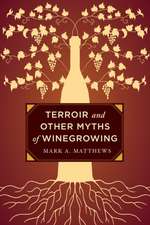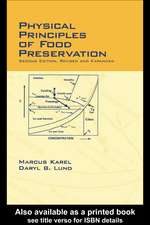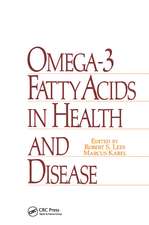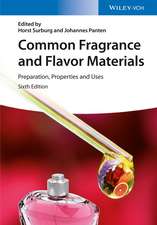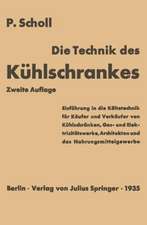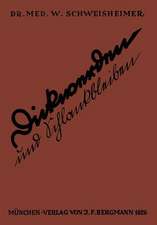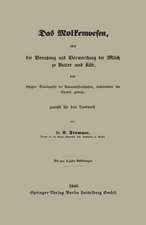Autoxidation in Food and Biological Systems
Editat de M.G. Simic, Marcus Karelen Limba Engleză Hardback – 31 oct 1980
| Toate formatele și edițiile | Preț | Express |
|---|---|---|
| Paperback (1) | 969.93 lei 6-8 săpt. | |
| Springer Us – 24 apr 2013 | 969.93 lei 6-8 săpt. | |
| Hardback (1) | 977.97 lei 6-8 săpt. | |
| Springer Us – 31 oct 1980 | 977.97 lei 6-8 săpt. |
Preț: 977.97 lei
Preț vechi: 1192.64 lei
-18% Nou
Puncte Express: 1467
Preț estimativ în valută:
187.13€ • 195.00$ • 154.95£
187.13€ • 195.00$ • 154.95£
Carte tipărită la comandă
Livrare economică 03-17 aprilie
Preluare comenzi: 021 569.72.76
Specificații
ISBN-13: 9780306405617
ISBN-10: 030640561X
Pagini: 659
Ilustrații: XII, 659 p.
Dimensiuni: 178 x 254 x 37 mm
Greutate: 1.38 kg
Ediția:1980
Editura: Springer Us
Colecția Springer
Locul publicării:New York, NY, United States
ISBN-10: 030640561X
Pagini: 659
Ilustrații: XII, 659 p.
Dimensiuni: 178 x 254 x 37 mm
Greutate: 1.38 kg
Ediția:1980
Editura: Springer Us
Colecția Springer
Locul publicării:New York, NY, United States
Public țintă
ResearchDescriere
The material presented in this book deals with basic mechanisms of free radical reactions in autoxidation processes and anitoxidant suppression of autoxidation of foods, biochemical models and biologi cal systems. Autoxidation in foods and corresponding biological effects are usually approached separately although recent mechanistic developments in the biochemistry and free radical chemistry of per oxides and their precursors tend to bring these two fields closer. Apparent ability of antioxidants in diets to reduce the inci dence of cancer has resulted in scrutiny of autoxidized products and their precursors as possibly toxic, mutagenic and carcinogenic agents. Mechanisms of any of these effects have been barely ad dressed. Yet we know now that free radicals, as esoteric as they were only a few decades ago, are being discovered in foods, biochem ical and biological systems and do play a role in the above-mentioned causalities. The purpose of the Workshop and the resulting book was to give a unifying approach towards study of beneficial and deleterious effects of autoxidation, based on rigorous scientific considerations. It is our hope that the material presented in this book will not only provide a review of the "state of the art" of autoxidation and anti oxidants, but also reflect the interaction which occurred during the Workshop between workers using model sytems, and food and biological systems.
Cuprins
Mechanisms of Autoxidation.- 1. Initiation of the Autoxidation of Polyunsaturated Fatty Acids (PUFA) by Ozone and Nitrogen Dioxide.- 2. Kinetic and Mechanistic Studies of Peroxy, Vitamin E and Anti-Oxidant Free Radicals by Pulse Radiolysis.- 3. Singlet Oxygen-Initiated Photooxidation of Unsaturated Fatty Acid Esters and Inhibitory Effects of Tocopherols and ?-Carotene.- 4. EPR Studies in Autoxidation.- 5. Spin Trapping of Radical Species Involved in the Propagation of Lipid Peroxidation.- 6. Dioxygen Complexes as Intermediates in Metal-Catalyzed Oxidation of Organic Substances.- 7. The Autoxidation of Cholesterol.- Food and Model Systems.- 8. Activities of FDA’S Division of Nutrition Regarding Cholesterol Oxides.- 9. Analytical Methods Used in the Study of Autoxidation Processes.- 10. Rapid Instrumental Analysis of Lipid Oxidation Products.- 11. Simplified Tests for Fat Deterioration.- 12. Lipid Oxidation, Secondary Reactions, and Water Activity of Foods.- 13. Autoxidation of Fats and Oils at Elevated Temperatures.- 14. Lipid Hydroperoxide Induced Oxidation of Cysteine in Peptides.- 15. Degradation Products of L-Tryptophan Reacted with Peroxidizing Methyl Linoleate.- 16. Oxidative Crosslinking of Proteins and Other Biopolymers.- Antioxidants.- 17. Natural Antioxidants.- 18. Natural Antioxidants of Soybeans and Other Oil-Seeds.- 19. Recent Trends in Food Applications of Antioxidants.- 20. Antioxidative Effect of Maillard Reaction Intermediates.- 21. Antioxidants as Blocking Agents Against Nitrosamine Formation.- 22. Optimization of the Antioxidant System in a Dietary Supplement.- Biochemical Systems.- 23. Peroxidation of Lipids in Model Systems and in Biomembranes.- 24. Superoxide Radical and Superoxide Dismutases: Threat and Defense.- 25. Lipid Enzymes: Lipases, Lipoxygenases, and “Hydroperoxidases”.- 26. Enzyme-Catalyzed Lipid Oxidation in Muscle Microsomes.- 27. Lipoxygenase-Catalysed Oxidation of Linoleic Acid.- 28. Lipid Peroxidation: The Role of Hepatic Fad-Monooxygenase.- Biological Systems.- 29. Intracellular Mechanisms for Lipid Peroxide Decomposition.- 30. Biological Effects of Some Products of Cholesterol Autoxidation.- 31. Possible Role of Oxidized Lipids in Atherosclerosis.- 32. Arterial Wall Injury and Repair Due to Oxygenated Sterols and Possible Precursors.- 33. Is Peroxidation Important in the Cancer Process.

